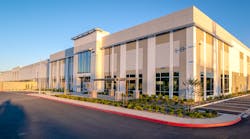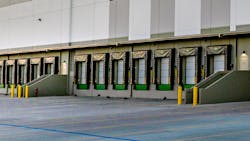Walmart said it's found a way to speed up a major link in its national supply chain model significantly with a new, high-tech consolidation center set to open this July. If it works out as planned, it could mean not only an increase several times over in the facility's freight processing speed but lower cost and greater ability to handle changes in supply and demand.
The consolidation center will be in Colton, CA in San Bernardino County. It'll be a 340,000-sq.-ft. facility with 150 full-time employees initially and expected to grow by another 450 over about two years.
Walmart has 10 of the consolidation centers, only not like this special one. They receive less-than-truckload freight shipments for all manner of products making their way to the retail stores and essentially collate freight into truckload shipments of products, according to the company.
From there, Walmart shipments go on to 42 regional distribution centers and the retailer's approximately 4,700 storefronts in the country. That much isn't new; the consolidation centers stack together shipments to lower costs and simplify distribution.
What's changing is that the new Colton consolidation center automates sorting, which Walmart said allows it to process three times more freight volume than an equivalent manually-run facility. And there's something else: order inaccuracies won't be able to get as far downstream.
Sorting freight manually, employees may not realize if a given supplier's shipment contains incorrect items, the company explained. "If Walmart ordered toothpaste and the request was accidentally fulfilled with mouthwash, associates won't know until the product reaches the regional distribution centers," and shoppers may not have products they want available.
The automated consolidation center will be able to scan in, sort, and validate order items as freight is aggregated. In the new model, problems and inaccuracies will show up much sooner and can be corrected faster.
"The new system enables suppliers to fill one massive order," Walmart noted, instead of many smaller ones destined for the regional distribution centers. "New software automatically scans and counts the product immediately when it arrives and documents the information in our systems, so Walmart will be able to react faster to order-filling issues."
The new center will also package freight smarter, putting together products "based on how they are stocked" so retail store employees can get them on shelves and for sale faster.
Walmart is also anticipating more flexibility to respond to unexpected needs and changes in supply and demand thanks to the high-tech consolidation center. "When it comes to reacting to unexpected events such as sudden changes in weather, having products separated and stored further upstream allows Walmart's supply chain to react even faster," according to the company.
Thus the new consolidation center will also be able to act like a warehouse and pivot more adeptly when needed. "With this new technology, we can be surgical and responsive in getting merchandise into stores," contended Geno Bell, senior director of the consolidation center network at Walmart.




